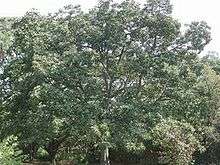Terminalia bellirica
Terminalia bellirica, known as bahera or beleric or bastard myrobalan, (Arabic: beliledj بليلج,[1] Sanskrit: Bibhitaka बिभीतक,[2] Aksha अक्ष[3]), is a large deciduous tree common on plains and lower hills in Southeast Asia, where it is also grown as an avenue tree. The basionym is Myrobalanus bellirica Gaertn. (Fruct. Sem. Pl. 2: 90, t. 97. 1791). William Roxburgh transferred M. bellirica to Terminalia as "T. bellerica (Gaertn.) Roxb.". This spelling error is now widely used, causing confusion. The correct name is Terminalia bellirica (Gaertn.) Roxb.[4]
| Terminalia bellirica | |
|---|---|
 | |
| Scientific classification | |
| Kingdom: | Plantae |
| Clade: | Tracheophytes |
| Clade: | Angiosperms |
| Clade: | Eudicots |
| Clade: | Rosids |
| Order: | Myrtales |
| Family: | Combretaceae |
| Genus: | Terminalia |
| Species: | T. bellirica |
| Binomial name | |
| Terminalia bellirica | |
The leaves are about 15 cm long and crowded toward the ends of the branches. It is considered a good fodder for cattle. Terminalia bellirica seeds have an oil content of 40%, whose fatty-acid methyl ester meets all of the major biodiesel requirements in the US (ASTM D 6751-02, ASTM PS 121-99), Germany (DIN V 51606) and European Union (EN 14214).[5] The seeds are called bedda nuts.[6]
In traditional Indian Ayurvedic medicine, Beleric is known as "Bibhitaki" (Marathi: "Behada or Bhenda") (Terminalia bellirica). Its fruit is used in the popular Indian herbal rasayana treatment triphala. In Sanskrit it is called bibhītaka बिभीतक. In India, Neemuch (A Town in Malwa Region of Madhya Pradesh) is a major trading centre of De-Skinned Baheda & Whole Fruits of Terminalia Bellirica . Terminalia Bellirica is widely collected in wild in Malwa region of Madhya Pradesh and is traded in Neemuch APMC Yard.
According to Dymock, Warden, Hooper: Pharmacographia Indica 1890 :
"This tree, in Sanskrit Bibhita and Bibhitaka (fearless), is avoided by the Hindus of Northern India, who will not sit in its shade, as it is supposed to be inhabited by demons. Two varieties of T. belerica are found in India, one with nearly globular fruit, 1/2 to 3/4 inch in diameter, the other with ovate and much larger fruit. The pulp of the fruit (Beleric myrobalan) is considered by ayurvedic physicians to be astringent and laxative, and is prescribed with salt and long pepper in infections of the throat and chest. As a constituent of the triphala (three fruits), i.e., emblic, beleric and chebulic myrobalans, it is employed in a great number of diseases, and the kernel is sometimes used as an external application to inflamed parts. On account of its medicinal properties the tree bears the Sanskrit synonym of Anila-ghnaka, or "wind-killing." According to the Nighantus the kernels are narcotic."[7]
In the Charaka Samhita, the ancient Ayurvedic text, Bibhitaki fruits are mentioned as having qualities to alleviate disease, and bestow longevity, intellectual prowess and strength. There are several "rasaayan" described in the Charaka Samhita, that use Bibhitaki.
Description of Fourth Amalaka Rasaayan, which includes Bibhitaki as one of the fruits:
By this treatment, the sages regained youthfulness and attained disease-free life of many hundred years, and endowed with the strength of physique, intellect and senses, practiced penance with utmost devotion.[8]
This kernels are eaten by the Lodha people of the Indian subcontinent for their mind-altering qualities.[9]
The nuts of the tree are rounded but with five flatter sides. It seems to be these nuts that are used as dice in the epic poem Mahabharata and in Rigveda book 10 hymn 34. A handful of nuts would be cast on a gaming board and the players would have to call whether an odd or even number of nuts had been thrown.[10] In the Nala, King Rituparna demonstrates his ability to count large numbers instantaneously by counting the number of nuts on an entire bough of a tree.[11]
| Wikimedia Commons has media related to Terminalia bellirica. |
Gallery
_trunk_at_23_Mile%2C_Duars%2C_WB_W_IMG_59023.jpg) Trunk of T. bellirica
Trunk of T. bellirica_hanging_fruit_at_23_Mile%2C_Duars%2C_WB_W_IMG_5902.jpg) Fruit of T. bellirica
Fruit of T. bellirica_fallen_fruit_at_23_Mile%2C_Duars%2C_WB_W_IMG_5900.jpg) A fallen fruit
A fallen fruit T. bellirica tree
T. bellirica tree
References
- Raymond, Arveiller (1999). Addenda au FEW XIX (Orientalia). Max Niemeyer Verlag Tübingen.
- Cologne Digital Sanskrit Dictionaries - Monier Williams Sanskrit-English Dictionary page 978
- Cologne Digital Sanskrit Dictionaries - Monier Williams Sanskrit-English Dictionary page 3
- IPNI database
- "Prospects and potential of fatty acid methyl esters of some non-traditional seed oils for use as biodiesel in India". Biomass and Bioenergy. 29: 293–302. doi:10.1016/j.biombioe.2005.05.001.
- http://www.cabicompendium.org/NamesLists/FC/Full/TEM_BE.htm
- PHARMACOGRAPHIA INDICA. HISTORY OF THE PRINCIPAL DRUGS OF VEGETABLE ORIGIN, MET WITHIN BRITISH INDIA, BY WILLIAM DYMOCK, 1890. page 5 &6
- Sharma, P. V. (1998). Caraka Samhita. Chaukhamba Orientalia. ISBN 81-7637-011-8.
- D. C. Pal, S. K. Jain, "Notes on Lodha medicine in Midnapur District, West Bengal, India", Economic Botany, October–December 1989, Volume 43, Issue 4, pp 464-470
- Bennett, Deborah (1999). Randomness. Boston: Harvard University Press. p. 24. ISBN 0-674-10746-2.
- "Nala & Damayanti 5: Nala learns the science of numbers". Math or Magic. Retrieved 12 February 2011.
External links
- Caldecott, Todd (2006). Ayurveda: The Divine Science of Life. Elsevier/Mosby. ISBN 0-7234-3410-7. Contains a detailed monograph on Terminalia belerica (Bibhitaki) as well as a discussion of health benefits and usage in clinical practice. Available online at https://web.archive.org/web/20110515075816/http://www.toddcaldecott.com/index.php/herbs/learning-herbs/389-bibhitaki